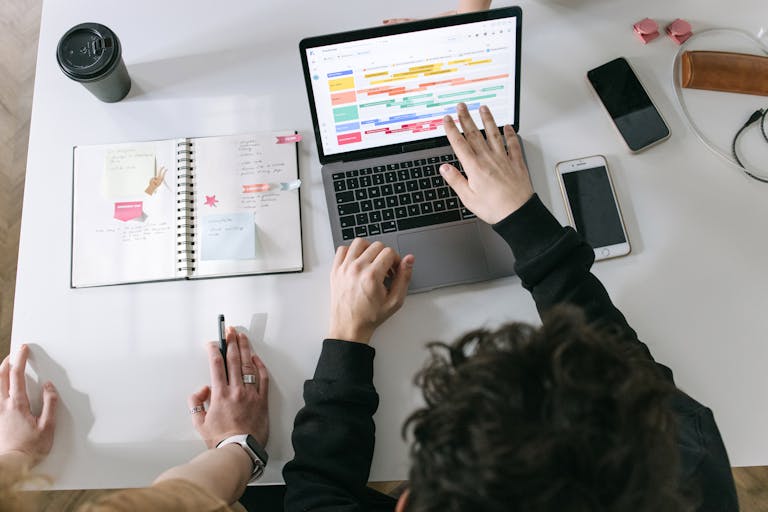In today’s digital world, the boundaries between work and personal life have become increasingly blurred. With constant access to emails, notifications, and work apps on our smartphones and laptops, it’s easy to feel like work never truly ends. Maintaining a healthy work-life balance is more important than ever, as an imbalance can lead to burnout, stress, and reduced productivity.
In this article, we’ll explore strategies for finding the right balance in the digital age, allowing you to prioritize self-care, personal time, and professional responsibilities without feeling overwhelmed.

1. Set Clear Boundaries
One of the most effective ways to achieve work-life balance is by setting clear boundaries between your professional and personal life. By defining when and where you work and when you disconnect, you can maintain a healthy balance and protect your personal time.
1.1 Establish Work Hours
Set specific work hours during which you are focused on professional tasks. After these hours, avoid checking work emails, responding to work-related messages, or engaging in any tasks that interfere with your personal time.
1.2 Create a Designated Workspace
If possible, create a dedicated workspace in your home that is solely for work. This physical separation between work and home life will help your brain associate certain spaces with professional responsibilities, making it easier to switch off once you leave that space.
2. Prioritize Self-Care and Downtime
In a world where the demands of work can often spill over into personal time, prioritizing self-care is essential. Taking regular breaks, engaging in hobbies, and spending quality time with loved ones are all important for maintaining your mental and physical well-being.
2.1 Schedule “Me Time”
Just as you schedule meetings or work tasks, schedule time for yourself. Whether it’s a walk, reading a book, or practicing yoga, make time each day for activities that recharge you. This is crucial for preventing burnout and keeping your productivity levels high.
2.2 Take Regular Breaks During Work
When working, be sure to take regular breaks to rest and refresh your mind. The Pomodoro Technique, which suggests working in 25-minute intervals with 5-minute breaks in between, can be a great way to stay productive while preventing mental exhaustion.
3. Manage Screen Time
With the rise of digital communication, it’s easy to spend excessive time in front of screens—whether it’s for work or leisure. Too much screen time can contribute to eye strain, headaches, and fatigue, so it’s important to manage how much time you spend on your devices.
3.1 Set Screen Time Limits
Use screen time tracking tools to set limits on how much time you spend on work-related tasks and leisure activities. Many devices have built-in features, such as “Do Not Disturb” modes and screen time monitoring apps, to help you stay on track.
3.2 Practice Digital Detox
Take regular breaks from screens to reset your mind. Consider scheduling a digital detox day each week or taking short breaks during the day to disconnect from technology. This will help you recharge and stay present in the moment.
4. Avoid Overcommitting
With the ease of communication provided by digital devices, it’s tempting to take on more responsibilities, whether at work or in your personal life. However, overcommitting can lead to stress and exhaustion. Learning to say no and set realistic expectations is crucial for maintaining a work-life balance.
4.1 Set Priorities and Delegate Tasks
Focus on what matters most and delegate tasks that don’t require your direct involvement. At work, this could mean delegating projects to team members. In your personal life, it may involve asking for help with household chores or family responsibilities.
4.2 Learn to Say No
It’s important to understand that it’s okay to say no to additional tasks or commitments that don’t align with your priorities or would negatively impact your well-being. Saying no helps you maintain control over your schedule and protects your time for rest and relaxation.
5. Leverage Technology to Enhance Balance
Technology doesn’t always have to be a source of stress—it can also be a tool for maintaining balance. From time management apps to mindfulness tools, there are many ways technology can help you stay organized and mindful of your work-life boundaries.
5.1 Use Time Management Tools
Apps like Trello, Asana, or Google Calendar can help you organize your tasks, set reminders, and ensure you stay on top of both work and personal commitments. By setting boundaries in your digital tools, you can avoid overloading your schedule.
5.2 Explore Mindfulness and Meditation Apps
Mindfulness and meditation can help you de-stress and clear your mind. Apps like Calm, Headspace, and Insight Timer offer guided meditations that you can use to relax and refocus throughout your day. These tools are invaluable for maintaining your mental health in the digital age.
6. Disconnect to Reconnect
Finally, one of the most important steps in achieving a healthy work-life balance is learning to disconnect from your devices, especially when you’re spending time with family, friends, or engaging in personal hobbies.
6.1 Turn Off Notifications
Turning off notifications for work-related apps during your personal time will help you stay focused on the moment and reduce the temptation to check your phone constantly.
6.2 Set Device-Free Zones
Designate areas of your home, such as the bedroom or dining room, as device-free zones. This will encourage quality time with your loved ones without distractions.
Q: How do I manage work-life balance when I work remotely?
A: Set clear work hours, create a dedicated workspace, and ensure that you fully disconnect at the end of your workday. Also, make time for breaks and personal activities to recharge.
Q: What’s the best way to avoid burnout in a digital world?
A: Prioritize self-care, manage screen time, and ensure you take regular breaks. It’s also essential to set boundaries and avoid overcommitting to work or personal obligations.
Maintaining a healthy work-life balance is possible, even in a world dominated by technology. Start implementing these strategies today, and take the first step toward achieving a balanced, fulfilling life. Disconnect to reconnect, and ensure that both your professional and personal lives thrive in harmony.

I’m EKBAL HOSSAIN MONDAL, the creator of SmartSolveTips.com — a blog dedicated to helping people improve productivity, avoid digital burnout, and live better online. With years of hands-on experience in self-development and digital wellness, I write practical tips and tools to help you stay focused and thrive in a fast-paced digital world.






